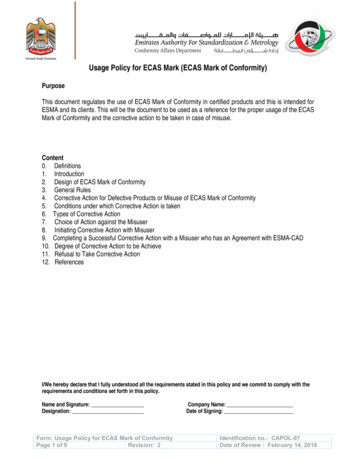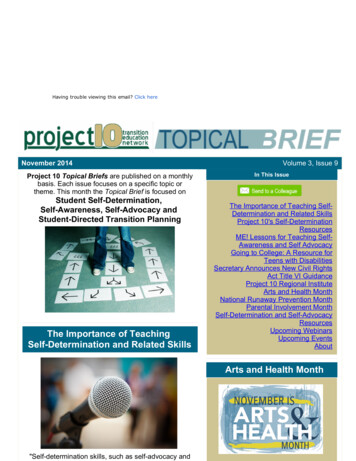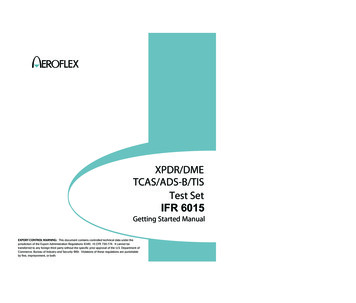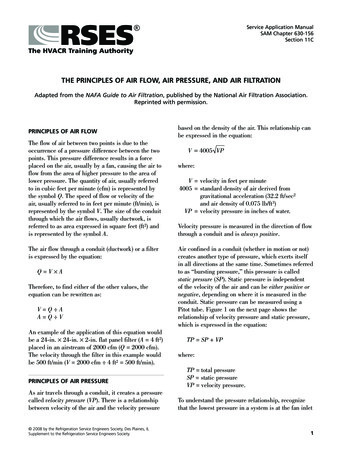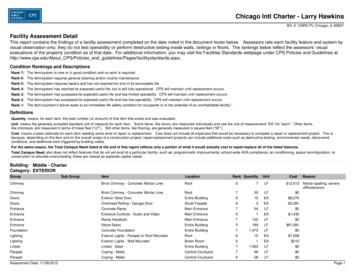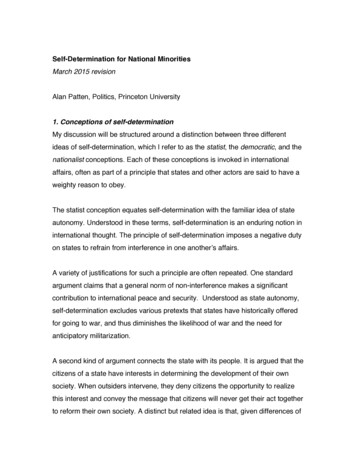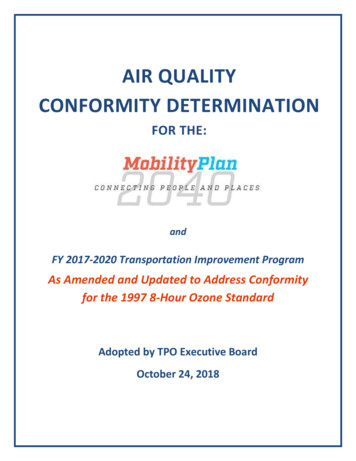
Transcription
AIR QUALITYCONFORMITY DETERMINATIONFOR THE:andFY 2017-2020 Transportation Improvement ProgramAs Amended and Updated to Address Conformityfor the 1997 8-Hour Ozone StandardAdopted by TPO Executive BoardOctober 24, 2018
Air Quality Conformity Determination Report for theKnoxville Regional TPO 2018 Update of the MetropolitanLong-Range Transportation Plan, known as the“Mobility Plan 2040”andthe accompanying Knoxville Regional TPOFY 2017-2020 Transportation Improvement ProgramPrepared by:Knoxville Regional TPO StaffFor additional information contact:Mike Conger, Senior Transportation EngineerKnoxville Regional TPOEmail: Mike.Conger@knoxtrans.orgPhone: 865-215-3813The preparation of this report has been financed in part through grant[s] from the Federal HighwayAdministration and Federal Transit Administration, U.S. Department of Transportation, under the State Planningand Research Program, Section 505 [or Metropolitan Planning Program, Section 104(f)] of Title 23, U.S.Code. The contents of this report do not necessarily reflect the official views or policy of the U.S. Department ofTransportation
ContentsAdopting Resolution by Knoxville Regional TPO Executive Board for Mobility Plan 2040 and Air QualityConformity Determination . vAdopting Resolution by Knoxville Regional TPO Executive Board for FY 2017-2020 TIP Amendments . viAdopting Resolution By Lakeway Area metropolitan Transportation Planning Organization ExecutiveBoard for Air Quality Conformity Determination . viiiApproval Letter by U.S. DOT for Air Quality Conformity Determination . ixExecutive Summary.1Overview and purpose .1Emissions Analysis Summary .22006 Daily PM2.5 Standard .22008 Ozone Standard .31997 Ozone Standard .4Summary Conformity Statement .5Chapter 1 - Introduction and Background Information .61.0 Introduction .61.1 Background on transportation Conformity .61.2 Background on the Knoxville Region Ozone and PM2.5 maintenance Areas .71.2.1 Ozone .71.2.2 PM2.5 .91.3 Emissions Analysis Background.101.4 Emissions Analysis Procedure .10Chapter 2 – Summary of Project Amendments . 122.0 Introduction .122.1 Analysis Year Modification .132.2 Non-Exempt Project Amendments To FY 2017-2020 TIP .142.3 Add Projects from TIP to MObility Plan .152.4 Revise Project Descriptions/Termini/Length for Consistency with TIP .162.5 Non-Exempt Projects within 1997 Ozone Area outside TPO Planning Area .17Chapter 3 – Planning Assumptions for Regional Emissions Analysis . 183.0 Introduction .183.1 Planning Assumptions for developing Travel Demand Forecasts: .183.2 Latest Emissions Model: .193.3 Emissions Tests: .19i
3.3.1 For 1997 “Annual” Ozone Standard .193.3.2 For 2008 8-Hour Ozone Standard .203.3.3 For 2006 “Daily” PM2.5 Standard .213.4 MOVES2014a Inputs and Runspec Development: .213.4.1 MOVES2014A Runspec Parameters .213.4.2 MOVES2014a County Data Manager Input Development .22Chapter 4: Mobile Source Emissions Analysis and Applicable Governing Regulations . 254.0 Introduction .254.1 Regulations related to Development of LRTP and Transportation Conformity .254.2 Regulations Governing Mobile Source Emissions Analyses .254.2.1 For Ozone (1997 Standard): .264.2.2 For Ozone (2008 Standard): .264.2.3 For PM2.5 (Daily Standard): .264.3 Availability of Technical Information Related to Emissions Analyses .29Chapter 5 – Statement of Conformity . 305.0 Introduction .305.1 Statement of Conformity – 1997 8-Hour Ozone Standard .305.1.1 Summary of 1997 8-Hour Standard Conformity Analysis .315.2 Statement of Conformity – 2008 Ozone Standard.315.2.1 Summary of 2008 8-Hour Standard Conformity Analysis .315.3 Statement of Conformity – 2006 Daily PM2.5 Standard.325.3.1 Summary of 2006 Daily PM2.5 Standard Conformity Analysis .32Chapter 6 – Interagency Consultation . 336.0 Introduction .336.1 Participating Agencies .336.2 Overview of Consultation Process .33Chapter 7 – Conclusion and Summary of Comments Received . 347.0 Conclusion .347.1 Transportation Control Measures .347.2 Public Involvement Summary .357.3 Public Comment and Response .35Appendix A – Emissions Summaries by County. 36A.1 Emissions for the 2008 8-Hour Ozone Standard Analysis .36A.2 Emissions for the 1997 8-Hour Ozone Standard Analysis .37ii
A.3 Emissions for the 2006 Daily PM2.5 Standards .38Appendix B – MOVES2014A Input Development Documentation. 39B.1 Background .39B.2 MOVES County Data Manager Input Data Sources .39B.2.1 Meteorology .39B.2.2 Source Type Population .39B.2.3 Age Distribution .43B.2.4 Vehicle Type Vehicle Miles Traveled (VMT) .43B.2.5 Average Speed Distribution .50B.2.6 Road Type Distribution .50B.2.7 Ramp Fractions .50B.2.8 Fueltype and Technologies .50B.2.9 Fuel.52B.2.10 I/M Programs .52Appendix C – Interagency Consultation. 53C.1 Interagency Consultation Participants .53C.2 Interagency Consultation Meeting Minutes .54C.2.1 Meeting minutes for IAC Conference Call on 6/4/18 .54C.2.2 Meeting minutes for IAC Conference Call on 7/13/18 .58C.2.3 Meeting minutes for IAC Conference Call on 8/10/18 .61C.2.4 Meeting minutes for IAC Conference Call on 8/29/18 .64C.3 planning assumptions for Iac review .66C.4 IAC Review of Partial Area Emissions Methodology .74C.5 Responses to Comments from IAC Participants .84Appendix D – Mobility Plan 2040 project list with exempt and regional significance status . 86D.1 Background .86D.2 List of all Mobility Plan Projects by County and Horizon Year .86List of TablesTable 1: MVEB Test for 2006 Daily PM2.5 Standard .3Table 2: MVEB Test for 2008 Ozone Standard .4Table 3: MVEB Test for 1997 Ozone Standard .4Table 4: Projects with Revised Analysis Years .13Table 5: Non-Exempt Project Amendments to FY 2017-2020 TIP .14Table 6: Projects Added from TIP to Mobility Plan .15iii
Table 7: Projects with Revised Descriptions/Termini/Length.16Table 8: Non-Exempt Projects within 1997 Ozone Area outside TPO Planning Area .17Table 9: MVEB for 1997 Ozone Standard .20Table 10: MVEB for 2008 Ozone Standard .20Table 11: MVEB for 2006 Daily PM2.5 Standard .21Table 12: MVEB Test for 1997 8-Hour Ozone Standard .30Table 13: MVEB Test for 2008 Ozone Standard .31Table 14: MVEB Test for 2006 Daily PM2.5 Standard .32iv
ADOPTING RESOLUTION BY KNOXVILLE REGIONAL TPO EXECUTIVE BOARD FOR MOBILITYPLAN 2040 AND AIR QUALITY CONFORMITY DETERMINATIONv
ADOPTING RESOLUTION BY KNOXVILLE REGIONAL TPO EXECUTIVE BOARD FOR FY 20172020 TIP AMENDMENTSvi
vii
ADOPTING RESOLUTION BY LAKEWAY AREA METROPOLITAN TRANSPORTATION PLANNINGORGANIZATION EXECUTIVE BOARD FOR AIR QUALITY CONFORMITY DETERMINATIONviii
APPROVAL LETTER BY U.S. DOT FOR AIR QUALITY CONFORMITY DETERMINATIONix
x
EXECUTIVE SUMMARYOVERVIEW AND PURPOSEThe Knoxville Regional Transportation Planning Organization (KRTPO) has conducted a regional emissions analysisto support an air quality conformity demonstration for an update to its Metropolitan Long-Range TransportationPlan (LRTP) known as the Mobility Plan 2040 and for resulting amendments to its FY 2017-2020 TransportationImprovement Program (TIP) to ensure that the TIP is a direct subset of the LRTP. The purpose of this report is todocument that the updated LRTP and TIP conform to federal regulations from the latest surface transportation actknown as “Fixing America’s Surface Transportation Act” (FAST Act) and the Clean Air Act Amendments of 1990.This action is considered a minor update to the LRTP as opposed to one of the major updates that occurs on a 4year cycle as required by the FAST Act. The last major update of the LRTP was adopted in April 2017 and anothermajor update is not due until April 2021. The main purpose for conducting this interim update is to address arequirement that resulted from a DC Circuit Court ruling on February 16, 2018 in a case brought by environmentalgroup petitioners against the Environmental Protection Agency (EPA). The case involved the treatment of certain“anti-backsliding” requirements that occur in the transition between old and new air quality standards. The EPAhad previously removed the requirement to conduct air quality conformity for the 1997 8-hour Ozone Standard forareas that were subject to the new, more stringent 2008 8-hour Ozone Standard. The Court ruled in favor of theplaintiffs who argued that this conformity requirement should remain. It should be noted, however, that EPA hasnot issued official guidance subsequent to the court decision and has in fact filed a petition for a rehearing of thecase. The Federal Highway Administration (FHWA) issued guidance on 4/23/2018 to comply with the intent of thecourt ruling by advising that certain actions would be considered on-hold including addition of non-exemptprojects to a Metropolitan Transportation Plan and TIP until conformity with the 1997 ozone NAAQS isdetermined.Therefore, in order to maintain a conforming long-range plan and allow air quality conformity non-exempt projectsto be added or amended to the current Transportation Improvement Program, the Knoxville TPO mustdemonstrate conformity to the 1997 Ozone Standard once again. This document serves that purpose as well asproviding an opportunity to address minor changes to the project list as described in a subsequent section.An Air Quality Conformity Determination for transportation plans and programs within the Knoxville Region isrequired since it is currently designated as a “Maintenance Area” for the Particulate Matter 2.5 (PM2.5) Daily andAnnual Standards and for the 8-Hour Ozone Standard. The United States Environmental Protection Agency (EPA)sets air quality standards through the Clean Air Act in order to protect human health and the environment fromunsafe levels of pollution. The transportation conformity process is used to ensure that federal funds will not bespent on projects that cause or contribute to any new violations of the National Ambient Air Quality Standards(NAAQS); increase the frequency or severity of NAAQS violations; or delay timely attainment of the NAAQS or anyrequired interim milestone.The Knoxville Region is currently subject to transportation conformity requirements based on the designationsunder three separate NAAQS in the following specific geographic locations: 1997 8-hour Ozone Standard – Anderson, Blount, Jefferson, Knox, Loudon, Sevier and part of Cockecounties. This standard was revoked by EPA, but currently conformity is required based on the FHWAguidance referred to above.1
Maintenance for 2008 8-hour Ozone Standard – Blount, Knox, and part of Anderson counties Maintenance for 2006 Daily PM2.5 Standard – Anderson, Blount, Knox, Loudon and part of RoanecountiesThere are portions of counties designated as Maintenance that lie outside of the KRTPO Metropolitan PlanningArea. The KRTPO compiles a single overall transportation plan that encompasses the entire Nonattainment andMaintenance areas for the purposes of demonstrating conformity for the entire region.EMISSIONS ANALYSIS SUMMARYIn order to be able to demonstrate conformity of the TPO’s transportation plans with the applicable NAAQS, aregional emissions analysis is performed using outputs from a regional transportation model and a mobile sourceemissions model from EPA known as “MOVES” (Motor Vehicle Emission Simulator). An estimate of emissions isgenerated for various required analysis years between the present year and the final year of the LRTP andcompared against allowable amounts that have been formally set as part of a State Implementation Plan known as“Motor Vehicle Emissions Budgets” (MVEB).2006 DAILY PM2.5 STANDARDThe PM2.5 air quality standard consists of two different measurement timeframes – an annual level and a dailylevel – based on the health effects that can occur for short-term versus long-term exposures. The designation as anonattainment area under the Annual PM2.5 Standard became effective on April 5, 2005 and the designation as anonattainment area for the Daily PM2.5 Standard became effective on December 14, 2009. The EPA approved aredesignation of the area to Attainment with a Maintenance Plan effective on August 28 and 29, 2017 for the dailyand annual standards respectively. The Region is meeting the current (2012) Annual PM2.5 Standard of 12 μg/m3and the 1997 Standard has been revoked by EPA, thereby removing the requirement to demonstrate conformityfor the Annual Standard.The EPA published a notice announcing a finding that the 2014 and 2028 Motor Vehicle Emissions Budgets (MVEB)for Direct PM2.5 and Oxides of Nitrogen (a PM2.5 precursor pollutant) included in the Maintenance SIP areadequate for the purposes of transportation conformity in the Federal Register / Vol. 82, No. 46, page 13347 onMarch 10, 2017. A regional emissions analysis was conducted using inputs consistent with both the SIP and otherlatest planning assumptions. The computed emissions from on-road mobile sources compared against the MVEB inthe 2006 Daily PM2.5 Maintenance Area for the analysis years of 2024, 2028 (interpolated), 2030 and 2040 areshown in Table 1.2
Table 1: MVEB Test for 2006 Daily PM2.5 StandardAnalysis YearDirect Particulate Matter 2.5:20242028203020401.220.670.670.670.52 0.49 0.44 0.46 2024202820302040MVEB42.7319.6519.6519.65Projected Emissions (tons per day)15.51 14.11 11.31 9.71 MVEBProjected Emissions (tons per day)Oxides of Nitrogen (NOx):2008 OZONE STANDARDThe nonattainment designation for the 2008 8-hour Ozone Standard became effective on July 20, 2012. Aredesignation request to Attainment with a Maintenance Plan was submitted to EPA by the Tennessee Departmentof Environment and Conservation (TDEC) in November 2014 and approved by EPA on July 13, 2015 with aneffective date of August 12, 2015. Therefore, as of August 12, 2015 the Knoxville Region is considered a“Maintenance Area” for the 2008 Ozone Standard.The EPA published a notice announcing a finding that the 2011 and 2026 Motor Vehicle Emissions Budgets (MVEB)for NOx and VOC included in the Maintenance SIP are adequate for the purposes of transportation conformity inthe Federal Register / Vol. 80, No. 133, page 39970 on July 13, 2015.A regional emissions analysis was conducted using inputs consistent with both the SIP and other latest planningassumptions, which are documented in Chapter 3 of this report. The computed emissions from on-road mobilesources compared against the MVEB in the 2008 Ozone Maintenance Area for the analysis years of 2024, 2026(interpolated), 2030 and 2040 are shown in Table 2.3
Table 2: MVEB Test for 2008 Ozone StandardAnalysis YearVolatile Organic Compounds ected Emissions (tons per day)7.35 6.00 5.32 4.14 202420262030204041.6217.6917.6917.6910.51 8.35 7.27 5.77 Oxides of Nitrogen (NOx):MVEBProjected Emissions (tons per day)1997 OZONE STANDARDThe 1997 8-Hour Ozone conformity analysis consists of a Motor Vehicle Emission Budget (MVEB) Test for ozoneforming emissions of “Volatile Organic Compounds” (VOC) and “Oxides of Nitrogen” (NOx). The MVEB wasestablished for the year 2024 as a part of the 8-Hour Ozone Redesignation Request and Maintenance Plan. Anotice announcing the effective date of September 30, 2010 for these budgets was published in Federal Register/Vol. 75, No. 178 on September 15, 2010. The results of the emissions analysis are summarized in Table 3.Table 3: MVEB Test for 1997 Ozone StandardAnalysis YearVolatile Organic Compounds (VOC):202420302040MVEB (1997 8-Hour for year 2024)25.1925.1925.19Projected Emissions (tons per day)13.34 9.90 8.02 202420302040MVEB (1997 8-Hour for year 2024)36.3236.3236.32Projected Emissions (tons per day)22.89 17.15 14.95 Oxides of Nitrogen (NOx):4
SUMMARY CONFORMITY STATEMENTIn summary, the emissions analysis performed by the KRTPO demonstrates that the projected emissions from theproposed transportation system are less than the allowable amount for each of the required analysis years andthus conformity for the 2008 8-Hour Ozone, Annual PM2.5, and Daily PM2.5 standards has been demonstrated forthe affected current transportation plans and the project amendments thereto.The conformity determination was coordinated with stakeholder and regulatory agencies through an InteragencyConsultation process and a 30-day public review and comment period was held. A summary of comments thatwere received and responses is included in the report.5
CHAPTER 1 - INTRODUCTION AND BACKGROUND INFORMATION1.0 INTRODUCTIONThe primary purpose of this document is to demonstrate that an update to the Knoxville TPO Metropolitan LongRange Transportation Plan, known as “Mobility Plan 2040” and the Knoxville Regional Transportation PlanningOrganization (KRTPO) FY 2017-2020 Transportation Improvement Program (TIP) (as amended) meetTransportation/Air Quality Conformity requirements of the Clean Air Act and Fixing America’s SurfaceTransportation Act (FAST Act).Federal Transportation Planning Regulations (23 CFR 450) require Metropolitan Planning Organizations to preparea comprehensive Long Range Transportation Plan (LRTP) that covers a minimum 20-year horizon. The LRTP isrequired to be updated every four years in order to ensure that the underlying planning assumptions are still valid.The TPO is also required to prepare a four-year program of projects known as a Transportation ImprovementProgram (TIP) that must be consistent with the approved LRTP.This conformity determination is not addressing one of the major update cycles of the LRTP and is instead aninterim update that was brought about primarily by a February 16, 2018 ruling by the DC Circuit Court. The caseinvolved the treatment of certain “anti-backsliding” requirements that occur in the transition between old andnew air quality standards where the new standard is more stringent than the old. The EPA had previously removedthe requirement to conduct air quality conformity for the 1997 8-hour Ozone Standard for areas that were subjectto the new, more stringent 2008 8-hour Ozone Standard. The Court ruled in favor of the plaintiffs who argued thatthis conformity requirement should remain. It should be noted, however, that EPA has not issued official guidancesubsequent to the court decision and has in fact filed a petition for a rehearing of the case. The Federal HighwayAdministration (FHWA) issued guidance on 4/23/2018 to comply with the intent of the court ruling by advising thatcertain actions would be considered on-hold including addition of non-exempt projects to a MetropolitanTransportation Plan and TIP until conformity with the 1997 ozone NAAQS is determined.In order to maintain a conforming long-range plan and allow air quality conformity non-exempt projects to beadded or amended to the current Transportation Improvement Program, the Knoxville TPO must demonstrateconformity to the 1997 Ozone Standard once again. This document serves that purpose as well as providing anopportunity to address minor changes to the Mobility Plan project list as described in a subsequent section.1.1 BACKGROUND ON TRANSPORTATION CONFORMITYTransportation Conformity is required in nonattainment and maintenance areas by federal regulations (40 CFRParts 51 and 93) and is the mechanism through which on-road mobile source emissions are addressed in the area’sgoals for
Air Quality Conformity Determination Report for the Knoxville Regional TPO 2018 Update of the Metropolitan Long-Range Transportation Plan, known as the "Mobility Plan 2040" and the accompanying Knoxville Regional TPO FY 2017-2020 Transportation Improvement Program Prepared by: Knoxville Regional TPO Staff For additional information contact:

